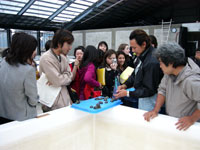
The main characteristic of the fishing industry on Izena island is that 90 percent of earnings come from mozuku seaweed. I’m not sure you have eaten mozuku on your trip so far, but the union deals with 90 percent of it. The rest is from fish and shellfish harvest. Mozuku is harvested after it has grown for half a year. To provide some income for the intervening months, we decided to start tokobushi farming, since tokobushi can be harvested throughout the year. We brought the tokobushi from Taiwan. Since the aquatic environment of Taiwan and Izena are very similar, we figured it might work. We’re not yet at the business stage of things, but we’re aiming to start shipping to Okinawa and the mainland.
It’s been three years since we started growing tokobushi, but we’re still unable to mass-produce. There are about one million at the point eggs are laid, but only about half of them grow to be two centimeters in diameter. Our next task is to figure out how to beat these odds. We hope to eventually bring the number to 400,000 a year.
No reproduction without permission